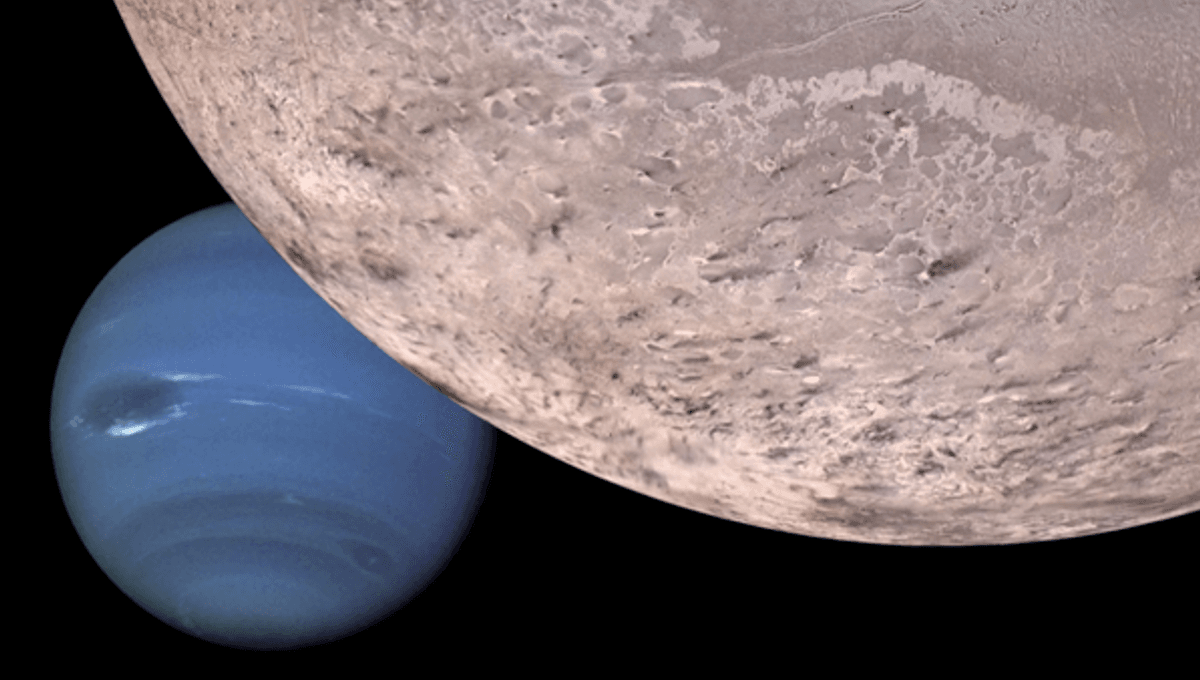
Aerospace engineers have proposed a way to send a mission to study Neptune for a fraction of the expected cost by using Triton’s atmosphere for the braking maneuver. Whether anyone will be willing to roll the dice on a still very expensive project, sweeping over the giant moon just right, remains to be seen, but it might at least get conversation going about such missions.
These are frustrating times if you want to study the outer Solar System by spacecraft. Jupiter has a current orbiter, one on the way and one set to launch next year. It’s hard to keep track of all the missions to Mars, and even Venus is getting attention again. Yet not only do Saturn, Uranus, and Neptune have no current guests, they won’t have one between them until 2034 at the earliest.
Planetary scientists keep finding interesting things in old data from Voyager 2, building a case to send an orbiter to at least one of the ice giants, but so far their pleas have been unanswered. The main reason is that it’s very expensive to pay more than a passing visit to such distant worlds. However, PhD candidate Jakob Brisby and Dr James Lyne of the University of Tennessee at Knoxville have a novel solution in their recent preprint.
Voyager 2 made it past all four giant planets with 1970s technology, but that was possible because it wasn’t trying to stop. To get into orbit around a distant planet it is necessary to either travel there very slowly, as JUICE is doing, or carry a lot of fuel so that you can perform a dramatic slowdown when you get there. The latter option is particularly expensive, because the fuel adds a lot of weight, increasing launch costs.
Brisby and Lyne wondered if there was another way to shed excess speed. Atmospheres are quite good for that, as any parachutist can tell you. Getting close enough to Neptune or Uranus to experience a braking force is almost certainly unviable, but they argue Triton could be a different matter.
Saturn’s moon Titan is often called the only satellite in the Solar System to have an atmosphere, but that is not quite true. All the larger moons have touches of surrounding gas, but the density is very low indeed.
Triton’s atmosphere is around 100,000 times thinner than Titan’s, but that’s still potentially enough to have the slowing effect required, provided the craft deploys a parachute or something similar to maximize drag.
The idea has added potential because Triton is the only large moon with a retrograde orbit, circling in the opposite direction the planet’s spin and most of the smaller moons. This makes it easier for a spacecraft to approach the system traveling in the same direction as Triton, minimizing their relative velocities, and therefore the stress the atmosphere would place on the craft.
NASA tested the LOFTID aeroshell last year, an inflatable craft whose forebody is a replica of the 1970s Viking entry vehicle. Its re-entry into the Earth’s upper atmosphere demonstrated the capacity of craft like this to use a very thin atmosphere to slow down without overheating. Brisby and Lyne use its design as the basis for their modeling in the yet-to-be-peer-reviewed paper.
That modeling reveals it’s theoretically possible to use a dip through Triton’s upper atmosphere to slow a spacecraft down to the point where it becomes locked in Neptune’s gravity well. The problem is you need to arrive at just the right point in Triton’s orbit, approach the giant moon at the right angle, and swoop to the appropriate altitude. The faster the spacecraft is going, the narrower the window is for the project to work without burning up, or leaving Triton with too much velocity and escaping the system entirely.
Even using a method like this, Brisby and Lyne anticipate it will take 15 years to get to Neptune, but that’s still a lot faster than alternative approaches. After all, it’s taking JUICE eight years to get to Jupiter, which is only one-seventh the distance.
The preprint, which has not undergone peer review, is available on ArXiv.org.
[H/T: Universe Today]
Source Link: How To Send A Mission To Neptune On The Cheap